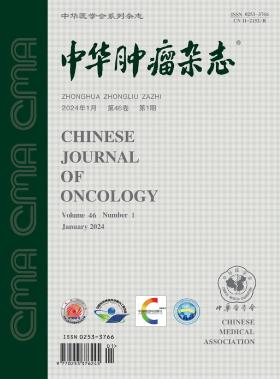[敲除低密度脂蛋白受体相关蛋白的表达对肝细胞癌血管异常的影响及其机制]。
摘要
研究目的研究低密度脂蛋白受体相关蛋白(LDLR)的表达对肝细胞癌(HCC)血管异常的影响及其机制。研究方法根据Oncomine癌症基因芯片数据库的信息,分析肝细胞癌组织中低密度脂蛋白受体相关蛋白的表达水平与癌胚抗原(CEA)和CD31表达水平的相关性。用慢病毒转染短发夹RNA靶基因构建LDLR敲除的MHCC-97H和HLE肝癌细胞。通过转录组测序、实时荧光定量聚合酶链反应和蛋白免疫印迹法检测了LDLR敲除肝癌细胞中的差异基因及其表达水平变化。通过富集分析,明确了涉及 LDLR 的基因相关信号通路。通过检测肝癌细胞条件培养基中的 CEA 含量,评估了 LDLR 对 CEA 的影响。血管生成试验用于检测 LDLR 对人脐静脉内皮细胞血管生成能力的影响,以及 CEA 在 LDLR 调节血管生成中的作用。免疫组化染色法检测了 176 例肝癌组织中 LDLR 的表达水平,以及 146 例肝癌组织中 CEA 和 CD31 的表达水平,并分析了组织中 LDLR、CEA 和 CD31 的表达水平与血清 CEA 和丙氨酸转氨酶(ALT)之间的相关性。结果Oncomine数据库分析显示,门静脉转移的肝细胞癌患者组织中LDLR和CEA的表达呈负相关(r=-0.64,P=0.001),而这些组织中CEA和CD31的表达呈正相关(r=0.46,P=0.010)。转录组测序结果显示,MHCC-97H细胞的LDLR敲除组和对照组共有1 032个差异表达基因,其中517个基因上调,515个基因下调。LDLR敲除组细胞中CEACAM5的转录表达水平明显上调。基因本体(GO)功能富集分析表明,差异基因在血管生成功能方面的富集最为明显。京都基因和基因组百科全书(KEGG)信号通路富集分析表明,涉及的相关通路主要包括细胞粘附补丁、细胞外基质受体相互作用以及与细胞外基质受体的相互作用。LDLR敲除组条件培养基中的CEA含量为(43.75±8.43),高于对照组(1.15±0.14,P<0.001)。血管生成实验结果显示,5 h时,LDLR-敲除组用MHCC-97H细胞条件培养液培养的HUVEC细胞形成的主连接数、主节段数和晶格总面积分别为295.3±26.4、552.5±63.8、2 239 781.0±13 8211.9平方像素,分别高于对照组(113.3±23.5、194.8±36.5、660 621.0±280 328.3平方像素,均P<0.LDLR敲除组的HUVEC细胞与HLE细胞在条件培养液中培养形成的血管主要连接点数、主要节段数和晶格总面积分别为245.3±42.4、257.5±20.4 和 2 535 754.5±249 094.2 平方像素,均高于对照组(分别为 113.3±23.5、114.3±12.2 和 1 565 456.5±219 259.7 平方像素,均 P<0.01)。在 MHCC-97H 细胞对照组的条件培养液中,培养的 HUVEC 细胞加入 CEA 后形成的主连接数、主区段数和晶格总面积分别为 178.9±12.0、286.9±12.3和1 966 990.0±126 249.5像素,分别高于对照组(119.7±22.1、202.7±33.7和1 421 191.0±189 837.8平方像素)。肝细胞癌组织中 LDLR 的表达与 CEA 的表达无关,但与 CD31 的表达(r=-0.167,P=0.044)、血清 CEA 水平(r=-0.061,P=0.032)和血清 ALT 水平(r=-0.147,P=0.05)呈负相关。肝细胞癌组织中 CEA 的表达与 CD31 的表达呈正相关(r=0.192,P=0.020)。血清 CEA 水平与血清 ALT 水平呈正相关(r=0.164,P=0.029)。结论敲除 LDLR 可通过释放 CEA 促进 HCC 血管异常。Objectives: To investigate the effect of the expression of low-density lipoprotein receptor associated protein (LDLR) on the vascular abnormalities in hepatocellular carcinoma (HCC) and its mechanisms. Methods: Based on the information of Oncomine Cancer GeneChip database, we analyzed the correlation between the expression level of LDLR and the expression level of carcinoembryonic antigen (CEA) and CD31 in hepatocellular carcinoma tissues. Lentiviral transfection of short hairpin RNA target genes was used to construct LDLR-knockdown MHCC-97H and HLE hepatocellular carcinoma cells. The differential genes and their expression level changes in LDLR-knockdown hepatocellular carcinoma cells were detected by transcriptome sequencing, real-time fluorescence quantitative polymerase chain reaction, and protein immunoblotting. The gene-related signaling pathways that involve LDLR were clarified by enrichment analysis. The effect of LDLR on CEA was assessed by the detection of CEA content in conditioned medium of hepatocellular carcinoma cells. Angiogenesis assay was used to detect the effect of LDLR on the angiogenic capacity of human umbilical vein endothelial cells, as well as the role of CEA in the regulation of angiogenesis by LDLR. Immunohistochemical staining was used to detect the expression levels of LDLR in 176 hepatocellular carcinoma tissues, and CEA and CD31 in 146 hepatocellular carcinoma tissues, and analyze the correlations between the expression levels of LDLR, CEA, and CD31 in the tissues, serum CEA, and alanine transaminase (ALT). Results: Oncomine database analysis showed that the expressions of LDLR and CEA in the tissues of hepatocellular carcinoma patients with portal vein metastasis were negatively correlated (r=-0.64, P=0.001), whereas the expressions of CEA and CD31 in these tissues were positively correlated ( r=0.46, P=0.010). The transcriptome sequencing results showed that there were a total of 1 032 differentially expressed genes in the LDLR-knockdown group and the control group of MHCC-97H cells, of which 517 genes were up-regulated and 515 genes were down-regulated. The transcript expression level of CEACAM5 was significantly up-regulated in the cells of the LDLR-knockdown group. The Gene Ontology (GO) function enrichment analysis showed that the differential genes were most obviously enriched in the angiogenesis function. The Kyoto Encyclopedia of Genes and Genomes (KEGG) signaling pathway enrichment analysis showed that the relevant pathways involved mainly included the cellular adhesion patch, the extracellular matrix receptor interactions, and the interactions with the extracellular matrix receptors. The CEA content in the conditioned medium of the LDLR-knockdown group was 43.75±8.43, which was higher than that of the control group (1.15±0.14, P<0.001). The results of angiogenesis experiments showed that at 5 h, the number of main junctions, the number of main segments, and the total area of the lattice formed by HUVEC cells cultured with the conditioned medium of MHCC-97H cells in the LDLR-knockdown group were 295.3±26.4, 552.5±63.8, and 2 239 781.0±13 8211.9 square pixels, which were higher than those of the control group (113.3±23.5, 194.8±36.5, and 660 621.0±280 328.3 square pixels, respectively, all P<0.01).The number of vascular major junctions, the number of major segments, and the total area of the lattice formed by HUVEC cells cultured in conditioned medium with HLE cells in the LDLR-knockdown group were 245.3±42.4, 257.5±20.4, and 2 535 754.5±249 094.2 square pixels, respectively, which were all higher than those of the control group (113.3±23.5, 114.3±12.2, and 1 565 456.5±219 259.7 square pixels, respectively, all P<0.01). In the conditioned medium for the control group of MHCC-97H cells,the number of main junctions, the number of main segments, and the total area of the lattice formed by the addition of CEA to cultured HUVEC cells were 178.9±12.0, 286.9±12.3, and 1 966 990.0±126 249.5 spixels, which were higher than those in the control group (119.7±22.1, 202.7±33.7, and 1 421 191.0±189 837.8 square pixels, respectively). The expression of LDLR in hepatocellular carcinoma tissues was not correlated with the expression of CEA, but was negatively correlated with the expression of CD31 (r=-0.167, P=0.044), the level of serum CEA (r=-0.061, P=0.032), and the level of serum ALT(r=-0.147,P=0.05). The expression of CEA in hepatocellular carcinoma tissues was positively correlated with the expression of CD31 (r=0.192, P=0.020). The level of serum CEA was positively correlated with the level of serum ALT (r=0.164, P=0.029). Conclusion: Knocking down LDLR can promote vascular abnormalities in HCC by releasing CEA.

 求助内容:
求助内容: 应助结果提醒方式:
应助结果提醒方式:


